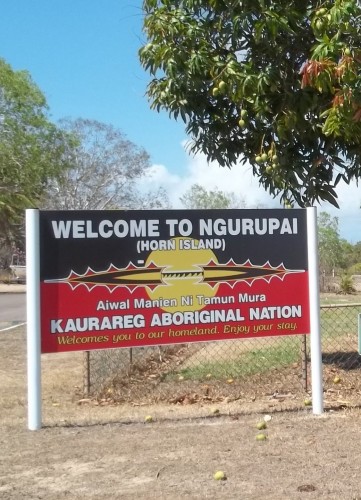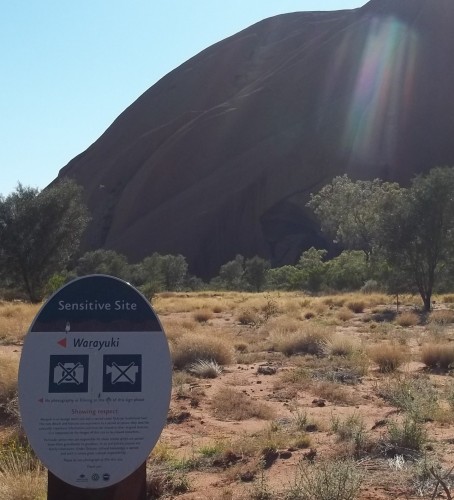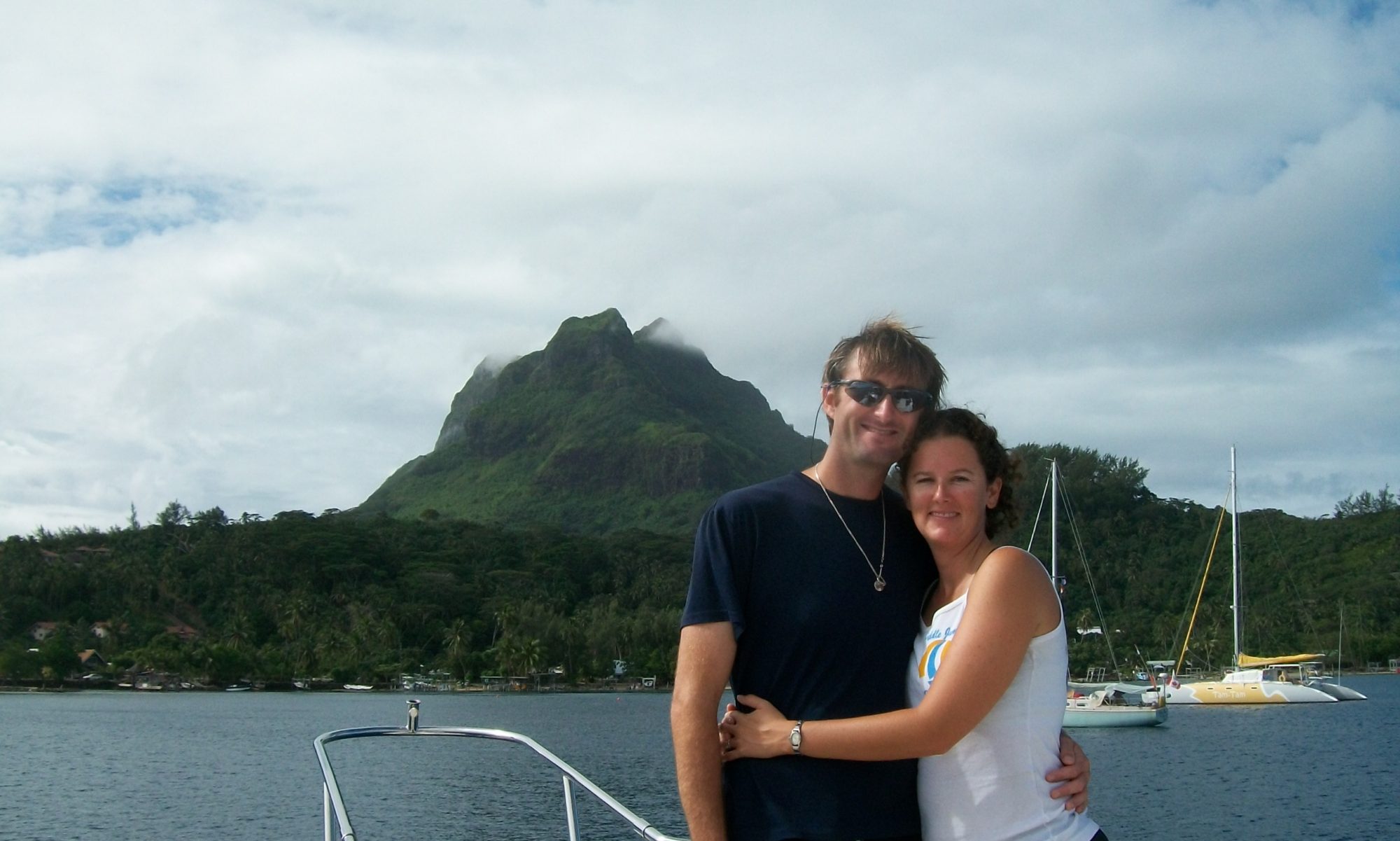Thursday Island, Australia
Thursday Island really excited us because it was, we were told, a really rare opportunity to spend some time with the native people of Australia.
 Which is, in case you’re wondering, a really, really hard thing to do.
Which is, in case you’re wondering, a really, really hard thing to do.
We also came to find out that the “Aborigines” are not the only native people of Australia. The “Torres Straight Islanders” are a completely different native people than the people of mainland Australia. So we actually spent some time visiting Aboriginal sites in mainland Australia but while we spent time in an area where there were “natives” these natives were not “Aborigines”…kind of confusing at first.
In a previous post, we talked about our experiences with racism and sexism in Australia.
But we would not be fair in our reporting unless we explained both sides of the coin here.
Because the natives do not make this easy.
The reason for this is that some aspects of the culture and traditions of the native peoples are radically different from those of the Western world from which the settlers of Australia hail.
And while this is all well and good and people can share ideas and learn from each other –
(challenging personal cultural assumptions is one of the great benefits of meeting new people)
– the core issue comes from the fact that in a few key areas, the culture of the native people of Australia are, for very justifiable reasons mind you, actually hindering relations rather than aiding it.
Allow us to elaborate:
(Now we are forced here to again paint with a very, very broad brush that is also heavily influenced by our own totally subjective experience. Just like every white Australian is not racist and sexist, not every indigenous Australian fits into these molds and in fact some oppose them. From elected officials to surgeons to Olympic gold medal athletes, Indigenous Australians have notably contributed in many areas to their home country. To even only use the 2 designations of “Aborigine” and “Torres straight islander” is a rather limited way to view the peoples who had over 200 distinct languages when the British arrived to colonize. We are talking at the macro level here because there is where we saw the largest disconnect between the different peoples of Australia.)
1st Cultural Difference – Dissemination of Information
The Aboriginals would never have invented the internet and it has nothing to do with technological competence.
It has to do with how their culture approaches the right of people to have access to information.
This, for us, was the biggest source of frustration when attempting to learn more about the native people of Australia because it was something that was not only contrary to our own cultural norms, it also by its very nature prevented us from completely understanding it.
We of the West are pretty firmly in the camp of “information sharing.” From storytellers to scribes to printing presses to typewriters to radio to television to the modern day where we experience all forms of media bombardment, over the last several hundred years the West has almost relentlessly pursued the ability to disseminate the most amount of information to the largest number of people as quickly as possible.
For us, there is too much information available for our consumption and we have been forced to find ways to filter some of the overload.
We’ve come to understand that this concept of freedom to access information is, and we’re not exaggerating here, the exact opposite of the culture of many indigenous Australians.
This was highlighted by a story we heard about one of the first encounters with the Aboriginals by Westerners. The Aboriginal leaders identified the leaders of the expedition of explorers and, as they were the leaders, told them all the information on the area. Water holes, animal migration patterns, what grows well, what wild fruit can be eaten and where to find it …that kind of stuff.
Then the explorers did what explorers do when they learn new stuff: they wrote it down and showed it to everyone – which was completely HORRIFYING to the leaders of the natives and basically convinced them that these new people were just not responsible enough to be trusted with important information…while the explorers scratched their heads and attempted to figure out why the Aboriginal leaders were keeping important information from their own people.
And we get it, it makes sense. The native peoples of Australia eked out an existence for centuries in a barren wasteland that would make most post-apocalyptic movies hang their heads in shame. Conservation of the available natural resources was not a good political tag line over in Australia back in the day – it was a matter of human survival.
Because in a situation like the ones the Aborigines lived in, telling every idiot with a spear where the only local flock of emus bed down for the night is a recipe for over-hunting and eventual death by starvation for their entire tribe – which is bad.
But when holding back information becomes so systemic to the culture that there are signs around Uluru pretty much saying “please don’t take pictures to the left of this sign because – well there’s a good reason but we can’t tell you”
 …It makes it hard for a Westerner to understand.
…It makes it hard for a Westerner to understand.
And when we want to learn more about their beliefs and people and we constantly run up against walls of “we can’t tell you” it’s a little frustrating – and quite frankly? Excluding. We understand that’s not what they are intending, but emotionally it’s difficult to not feel intentionally left out.
But then, here we are recreating the reason for the exclusion in the first place by posting information on the internet where anyone can access it. This post itself is THE REASON why we aren’t allowed access to even minor important information. Because we’ll just go out and tell everyone – and that’s bad in their minds.
Greg put it well when he began to understand that they have completely as a people embraced the ideas of “classified information” and “information security” but instead of, like in the West, pushing to declassify everything, the natives of Australia believe in moving information in the opposite direction – of classifying as much information as highly as possible.
Which makes it really hard to understand anything when you don’t have the clearance.
2nd Cultural Difference – Self-Isolation
This is one where, as Americans, we can at least begin to relate. More than once we have been asked “Why do all Americans want to own grenade launchers?” or “Why do you all like going to war all the time?” To which we often answer, “That’s not all of us, you’re just seeing one small subgroup, and a rather unflattering one at that, of a much larger group of people who just tend to keep to themselves.”
“Since Americans tend to stay in their own country almost all the time,” we explain, “whenever you see an isolated example that paints us in a bad light it’s important to remember that the painting is magnified by the fact that you don’t see the rest of us who likely are a lot more like you than you may think.”
Like Americans in relation to the rest of the world, the native peoples of Australia tend self-isolate. Some groups go so far as to live on their own in their native lands and follow their native ways of life. Others live in modern towns but those towns are of mostly made up of natives and again are isolated from others.
In some ways this sounds noble and desirable: preserving history for future generations and allowing people to maintain their unique culture. And we get it, it makes sense. They want to ensure their way of life continues on and the best way to do that is to keep their society’s members together in one place. Also as we will mention below, the immigrants to the natives’ land have done some pretty harsh things to the natives in the past so there is some serious cultural mistrust there as well alongside some real racism that even we encountered. Fair enough.
Unfortunately keeping themselves separate also has the unintended consequence of leaving the only natives we see as the ones who are not allowed to live with their own tribes. This is usually due to the fact that they have been thrown out. As in: the criminals, the drunks, the vagrants.
So it is the outcasts that are the most often seen ambassadors of the native Australians to the world – and they aren’t doing a very good job.
For example, it is not an uncommon sight in the outback towns to see a line of “aborigines” waiting for the pub to open so they can go drink and gamble. While this might not be indicative of the typical indigenous Australian, it becomes difficult to remember when that is the majority of what we see.
3rd Cultural Difference – Reverse Racism
Racism does go both ways in Australia. From simple prejudice to segregation to outright violence, predisposition about people due to the color of their skin is mutual.
And we get it, it makes sense. The white people did some seriously, horribly messed up stuff to the Aboriginal people.
Slavery, state sanctioned kidnapping of children, forced reeducation camps, attempts at extermination, that stuff was freaking sick.
But when we as travelers get lumped into the same group as the people who did those horrible things just because our skin pigmentation happens to be similar… When doctors volunteering in the outback get death threats from their patients just because of the color of their skin…well… isn’t that pretty much the same thing?
Racism is inexcusable in all its forms and no matter who is being prejudiced against.
So not only does Australia have to deal with racism, even after surmounting that there is still a massive cultural divide that must be navigated before any real work can be accomplished.
It’s a hard road, fraught with setbacks and both sides struggle with it time and again.
However they continue to struggle and despite it all make progress. While we would say that they don’t have it figured out yet and that progress can be slow, they also as a country have made some massive strides.
The Australian government famously and publicly apologized for their history of abuse to their native population. That’s not a solution and it’s a heck of a step in the right direction.
And in the face of such difficulty, of prejudice of the people on both sides and the inherent conflicts in both groups’ cultural norms, to keep struggling, while it does not excuse the need for more progress on both sides, does speak well for the people of Australia. All of them.
For more on our experiences with the racism and the effects in Australia you can check out our article from the opposite perspective in the imperfect mirror.
Greg and Tiffany are traveling around the world on sailing yachts and keep a video blog of their (mis)adventures. If sailing to Tahiti on a 44 ft sailboat, 3-day delays for wine tastings, getting pooped on by seagulls, opening coconuts with dull machetes, sailing past tornadoes and ukulele Christmas carols are for you, then check them out at www.CoastGuardCouple.com!


Great article, as well as the sister one. I too have had some very confronting and frustrating situations while trying to make sense/assist with this cultural situation. I was invited to be a consultant to indigenous Australians who were developing land for a environmental cultural center. They had a great story, but I can’t tell it here for the reasons you have outlined. Despite the funding available if they could tell SOME of the story, such as what is on the land, it was still a very firm “no.” There is a need and want for progress, but how to achieve this is going to be a tough puzzle for all parties involved.
It’s a tough road you all must walk together each and every day. I respect all of you so much more for, despite knowing that, choosing to walk it anyway.